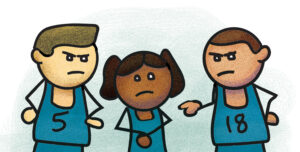I’ve spent several pleasant mornings and evenings in the month of March presenting workshops for various extended school day programs. I love talking to these groups because we have so much in common. We, as adults who enjoy the company of kids, are also the front line connection to helping kids learn the important lessons that encompass social-emotional learning.
For those of us in our generation, we remember coming home from school and being sent outside to play. Out there, in the wild, is where many of us learned what worked and what didn’t when it came to peer interactions. If I was bossy or too controlling, the neighborhood kids would go home. If I wasn’t nice, they weren’t nice. We chanted “sticks and stones.” We learned how to avoid the “bullies.” Our parents didn’t have a direct connection to where we were or what we were doing.
These days, the after-school life of kids is typically vastly different than what we experienced. There are many more opportunities for learning more about specific interests, organized sports, etc. Many families with both parents working are utilizing the terrific folks at after-school programs. With this change though, there are more adults in a child’s life than there used to be. Kids are well-supervised in their after school interactions. There is the benefit of less risk of physical injury, making sure homework is done and having an adult intervene when problems arise. Certainly, I can think of several childhood experiences in my own life out in the wild that I wish an adult had been available for help and guidance.
There is, however, a different risk, that might not be so beneficial to kids. At these workshops, we’ve discussed the tendency of kids to rely on adults to solve all of their problems, even the small ones. Many children are not developing the coping skills needed to deal with adversity.
The discussions turned to just how much adults should involve themselves in the play of children. Where do we step in and where do we step back? Personally, I think it is a balance that can be managed when done purposefully. It’s important when observing kids in moments of conflict or adversity (that isn’t physical or aggressive) to wait and see what they are capable of in terms of problem-solving. And then, if needed, teach them to problem solve, rather than solve it for them. And if it isn’t a problem that can be solved the way a child wants or demands it be solved, teach them the coping skills necessary to overcome the moment or the challenge. Resilience is built one coping thought at a time.


